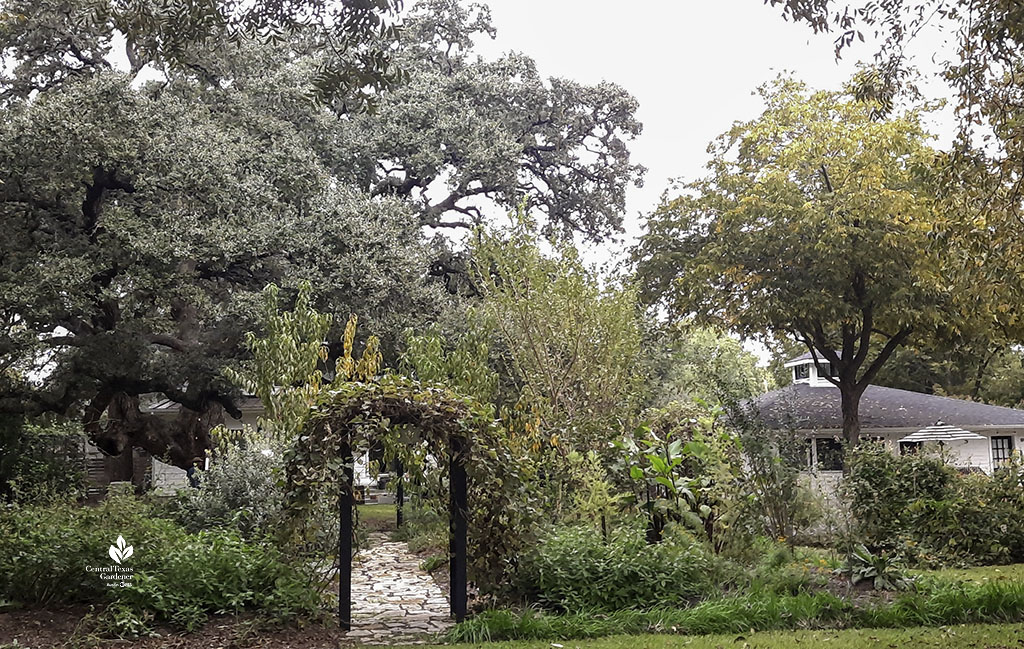[ad_1]
June 17, 2024
Permaculture Design: Raised Beds and Meals Forest

“I began out eager to develop meals for my husband and I, after which I discovered I take pleasure in rising the meals for the bugs and the bees and the butterflies probably the most,” Lockhart gardener Donna Daniels advised us final November.
Gardening was new to her, although, when she and husband Len Gabay scooted out of Austin to Lockhart and an enthralling house inbuilt 1888. They renovated its previous carriage home into a beautiful B&B, Prairie Lea Carriage Home.
Raised limestone beds have been already in place, however additionally they wished gardens in a spot that had been a concrete pad.
So, they reached out to Taelor Monroe, who they’d met a backyard speak in Austin. Taelor’s the proprietor and co-director of the Austin Permaculture Guild with Caroline Riley and founding father of model new The Cosmos Ranch Basis, a brand new location for APG and a neighborhood therapeutic venue.
Working round historic reside oak timber and established pecans, Taelor designed a meals forest of fruiting timber and shrubs, berries, vines, and meals and flowers that nurture households and wildlife.
“Permaculture actually focuses on quite a lot of perennial meals programs in order that it’s not as a lot labor. Fruit timber do take time, after all, to ascertain, however as soon as they’re established, they’re simply producing meals for you. Desirous about these particular crops which can be going to maintain producing with out you having to replant each season are actually nice,” she advised us. Perennials embody yarrow, comfrey, culinary herbs, asparagus, artichokes, and perennial leeks, chives, and onions. There are additionally asters, Mexican honeysuckle, turk’s cap, and salvias.
Right here’s her partial start line plant lists for the meals forest and raised beds.
Taelor additionally targeted on flood management, since each heavy rainfall despatched water swooshing down the yard, eroding topsoil alongside the best way. She designed the meals forest with berms (raised areas) and swales (depressed areas) to catch, direct, and infiltrate water. Alongside the property, she piled up twigs, branches, leaves, and different decaying plant matter to create Hügelkultur beds, a time-honored resourceful planting method.
Adjoining beds host perfume, edible perennials, and wildlife meals, together with roses, asters, Mexican mint marigold, Turk’s cap, and salvias of every kind. “The opposite factor I discovered with gardening is you make it stunning, then there’s a purpose so that you can be on the market,” Donna stated. “And I like this. I consider it as somewhat waystation for bugs that they will come and everybody’s welcome right here. And I attempt to have one thing for everybody to munch on.”
Seasonal annuals be a part of perennials within the raised beds, the place Donna mixes herbs, flowers, and greens. One among her favourite edibles—lamb’s quarters—towers close by. She welcomes its random seeding out. In actual fact, that’s the place she’s going with gardening: blissful accidents. “If issues wish to volunteer, that’s a free supply of meals. I’m not going to drag that volunteer out. I’m going to say thanks,” she stated.
And in Texas, she’s blissful to reap summer time’s basil whereas cool climate seedlings develop up.
Vertical gardening maximizes house, together with for these summertime luffas that she was letting dry naturally after composting their spent vines. However, in a cost-saving second, she went for fencing that works for luffas and different mild crops. Because it turned out, not such a good suggestion for hefty pumpkins!
Now, she’s added sturdier cattle panel for the heavyweights. In cool climate, they assist this yr’s peas—although fencing or a tomato cage works for peas, too.
A remaining infrastructure challenge: putting in a ten,000-gallon cistern to irrigate the meals forest and raised beds.
On our go to, Donna praised Inevitable Tech, an indoor-grower utilizing resourceful strategies to provide crops to growers and nurseries. In addition they open to the general public for “dig your individual” seedlings, many for simply $2.00.
In late spring, my husband and I made a day journey to Lockhart for a fast tour of the climate-controlled facility the place they develop seasonal greens, herbs and flowers.
Even native crops!
Watch now!
Thanks for stopping by! Linda
[ad_2]


